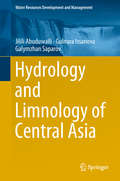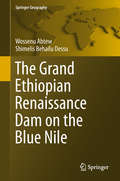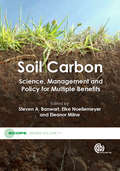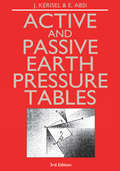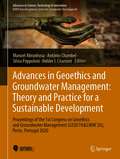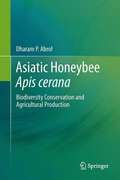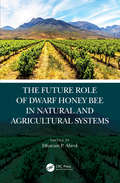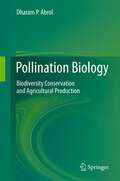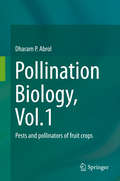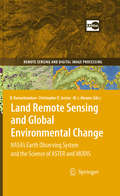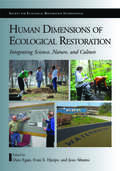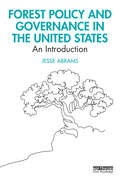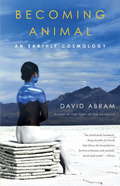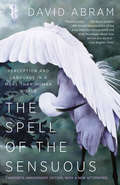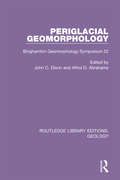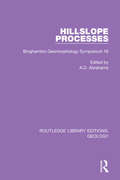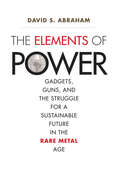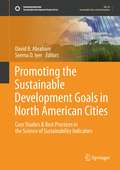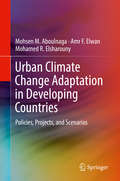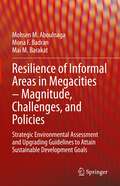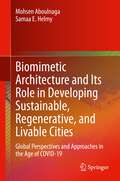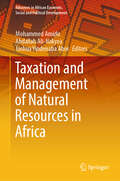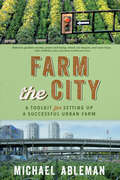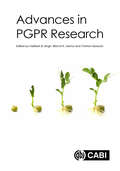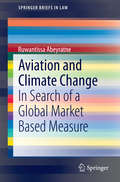- Table View
- List View
Hydrology and Limnology of Central Asia (Water Resources Development and Management)
by Jilili Abuduwaili Gulnura Issanova Galymzhan SaparovThis book highlights the development of lake systems and water reservoirs as well as the impact of climate change on water resources in Central Asian countries. It provides information on the genesis of lake basins, physical and chemical properties of water in lakes, and the hydrological regimes (water balance and fluctuation levels) of lakes of Central Asia and Xinjiang. The book is useful for scientists and researchers whose work focuses on lakes and the use of natural resources, irrigation, hydropower and water supply, as well as for students and planners.
The Grand Ethiopian Renaissance Dam on the Blue Nile (Springer Geography)
by Wossenu Abtew Shimelis Behailu DessuThis book is about the Grand Ethiopian Renaissance Dam newly being built on the Blue Nile, a transboundary river. Due to rising population and increasing water demand in the Nile basin, major projects raise interest and concern by millions with potential for water conflict. The dam design, reservoir filling policy, operation of the dam, riparian countries response, dam site importance and social impact and economy of the dam are presented in the book.
Soil Carbon: Science, Management and Policy for Multiple Benefits
by Dave Abson Christiano Ballabio Francesca Bampa Andre Bationo Niels Batjes Martial Bernoux Tapas Bhattacharyya Daniel Buschiazzo Carlos Eduardo Cerri Rich Conant Heitor L.C. Coutinho Chris Duffy Christian Feller Roger Funk Patrick Gicheru Marty Goldhaber Hans Joosten Pierre-Alain Maron Luca Montanarella Generose Nziguheba Genxing Pan Unai Pascual David Powlson Pete Smith Meine Van Noordwijk Bas Van Wesemael David Werner Yongcun ZhaoThis book brings together the essential evidence and policy opportunities regarding the global importance of soil carbon for sustaining Earth's life support system for humanity. Covering the science and policy background for this important natural resource, it describes land management options that improve soil carbon status and therefore increase the benefits that humans derive from the environment. Written by renowned global experts, it is the principal output from a SCOPE rapid assessment process project.
Active and Passive Earth Pressure Tables
by E. AbsiThe problem of earth pressure on retaining structures is one of the oldest in soil mechanics. This volume comprises tables which facilitate calculations in problems of limit equilibrium. These tables provide coefficients which are extreme values in which the soil still is in equilibrium. They are or
Advances in Geoethics and Groundwater Management: Proceedings of the 1st Congress on Geoethics and Groundwater Management (GEOETH&GWM'20), Porto, Portugal 2020 (Advances in Science, Technology & Innovation)
by Manuel Abrunhosa António Chambel Silvia Peppoloni Helder I. ChaminéThis book gathers the peer-reviewed proceedings of the 1st congress on Geoethics & Groundwater Management (GEOETH&GWM'20), held in Porto, Portugal, in an online format on 18-22 May 2020. Hosted in School of Engineering (ISEP), Polytechnic of Porto based on Porto city (a UNESCO World Heritage Site), the international conference focused on what has now been dubbed “hydrogeoethics”, a novel transdisciplinary, scientific field integrating all dimensions of geoethics in groundwater science and practice. Given its scope, the book is of interest to all researchers and practitioners in the geosciences, hydrology, water resources, hydrogeology, natural resources management, environment, engineering, law, sociology, education, philosophy, culture, among others.This joint congress is the result of a collaborative agreement between the IAH (International Association of Hydrogeologists) and IAPG (International Association for Promoting Geoethics) and reflects the need for concerted actions to achieve sustainable development.The diversity, scale, significance and increasing magnitude of anthropogenic interactions with aquifers and groundwater, which often involve conflicting values or interests, call for analysis, discussions and decisions on the part of the agents involved, e.g. groundwater scientists, policymakers, managers, organisations, professionals and citizens. This approach calls for a responsible, sustainable and human approach to groundwater use and management.The groundwater community involved in the exploration and exploitation, use and management of this increasingly vital natural resource is becoming more and more aware that ethical issues pervade all our attitudes from concept to action and need to be addressed. Diverse values and cultures, science and education, law and policies, human and natural environments and the public and the economic sectors view groundwater and its value and/or role differently. The authors believe that in a globalised and interconnected world, common ground must be found in the interest of peace, human development and sustainability. The main topics covered here include:1. Fundamentals of hydrogeoethics: cultures, principles and geoethical values on groundwater science and engineering2. Lessons for a resilient and sustainable future with hydrogeoethics: case studies of geoethics in groundwater science-engineering, profession, and management3. Scientific and humanistic components of hydrogeoethics in groundwater education and professional training 4. Socio-hydrogeology and ethical groundwater management 5. Geoethics of decision making under uncertainty and ethical issues in neglecting groundwater functioning 6. Groundwater: geological, legal, social, and ethical challenges of a unique natural resource
Asiatic Honeybee Apis cerana: Biodiversity Conservation and Agricultural Production
by Dharam P. AbrolDespite its economic usefulness, biodiversity of Asian hive bee Apis cerana is suffering precipitous decline and is threatened with extinction in its entire native habitat. Although a number of publications have appeared on honeybees in the market no attempt has been made to approach the subject in systematically and in a comprehensive manner in case of Apis cerana. There is still not enough knowledge on different facets of biological conservation, agricultural production and role in improving food security and livelihoods. An attempt has been made in this book to fill the gap by providing detailed information on different aspects of Apis cerana leading to sustainability and environmental protection. This book discusses information on varied aspects of Apis cerana biology, biogeography, reproduction, genetics, molecular phylogeny, interaction with other species, floral resources, dance language, safety from pesticides, management problems, loss of genetic diversity, behavioural defence, role in food production, livelihood security and conservation strategies for protecting biodiversity and enhancing crop productivity. The compilation of this book is unique in the sense that in the context of pollinator decline over the world, conservation of this species will be a step for sustaining food security.
The Future Role of Dwarf Honey Bees in Natural and Agricultural Systems
by Dharam P. AbrolThe future role of dwarf honeybees in natural and agricultural systems provides multidisciplinary perspective about the different facets of dwarf honeybees. The role of dwarf honeybee Apis florea assumes utmost importance in the context of pollinator decline throughout the world threatening stability of ecosystems and global food security. Apis florea is a low land species of south Asia extending more to the west than other Asiatic Apis species. It is an important pollinator of crops in hot and dry agricultural plains. The book is first of its kind which deals in details on varied aspects of Apis florea biology, management, conservation strategies for protecting biodiversity and enhancing crop productivity. The book aims to promote a large, diverse, sustainable, and dependable bee pollinator workforce that can meet the challenge for optimizing food production well into the 21st century. Features: Apis florea provides source of livelihood in mountainous areas and marginal farmers. This book will for the first time present the beekeeping from the perspective of agricultural production and biodiversity conservation An excellent source of advanced study material for academics, researchers and students and programme planners Excellent pollinator of tropical and subtropical crops fruits vegetables etc less prone to diseases and enemies Covering the latest information on various aspects of Apis florea biology, this book brings the latest advances together in a single volume for researchers and advanced level students This book will be useful to pollination biologists, honeybee biologists in entomology departments, students, teachers, scientists of agriculture, animal behaviour, botany, conservation, biology, ecology, entomology, environmental biology, forestry, genetics, plant breeding, horticulture, toxicology, zoology, seed growers and seed agencies and shall serve as reference book for students, teachers, researchers, extension functionaries and policy planners.
Pollination Biology
by Dharam P. AbrolThis book has a wider approach not strictly focused on crop production compared to other books that are strictly oriented towards bees, but has a generalist approach to pollination biology. It also highlights relationships between introduced and wild pollinators and consequences of such introductions on communities of wild pollinating insects. The chapters on biochemical basis of plant-pollination interaction, pollination energetics, climate change and pollinators and pollinators as bioindicators of ecosystem functioning provide a base for future insights into pollination biology. The role of honeybees and wild bees on crop pollination, value of bee pollination, planned honeybee pollination, non-bee pollinators, safety of pollinators, pollination in cages, pollination for hybrid seed production, the problem of diseases, genetically modified plants and bees, the role of bees in improving food security and livelihoods, capacity building and awareness for pollinators are also discussed.
Pollination Biology, Vol.1
by Dharam P. AbrolThe book covers interplay between pest management strategies and safety of pollinators. Detailed information is provided on pests and pollinators of temperate, subtropical and tropical fruit crops. Most of the fruit crops are highly cross pollinated and depend upon insects or benefit from insect pollination for fruit set. Insect pests on the other hand cause major economic damage on fruit crops in tropics, subtropics and temperate. Evidently, pest management in fruit crops on one hand and providing safety to the pollinators on the other is a challenging task in the context of increasing horticultural productivity without upsetting the ecological balance. This book aims to integrate and develop pest control strategies in a way to minimize their impact on beneficial insect species such as natural enemies and pollinators to enhance fruit production and quality. The book covers interplay between pest management strategies and safety of pollinators. Detailed information is provided on pests and pollinators of temperate, subtropical and tropical fruit crops. Pollinators play a crucial role in flowering plant reproduction and in the production of most fruits and vegetables. Most of the fruit crops are highly cross pollinated and depend upon insects or benefit from insect pollination for fruit set. Insect pests on the other hand cause major economic damage on fruit crops in tropics, subtropics and temperate. Evidently, pest management in fruit crops on one hand and providing safety to the pollinators on the other is a challenging task in the context of increasing horticultural productivity without upsetting the ecological balance. This book aims to integrate and develop pest control strategies in a way to minimize their impact on beneficial insect species such as natural enemies and pollinators to enhance fruit production and quality. Most of the fruit crops are highly cross pollinated and depend upon insects or benefit from insect pollination for fruit set. Insect pests on the other hand cause major economic damage on fruit crops in tropics, subtropics and temperate. Evidently, pest management in fruit crops on one hand and providing safety to the pollinators on the other is a challenging task in the context of increasing horticultural productivity without upsetting the ecological balance. This book aims to integrate and develop pest control strategies in a way to minimize their impact on beneficial insect species such as natural enemies and pollinators to enhance fruit production and quality. The book covers interplay between pest management strategies and safety of pollinators.
Land Remote Sensing and Global Environmental Change
by Michael J. Abrams Christopher O. Justice Bhaskar RamachandranLand Remote Sensing and Global Environmental Change: The Science of ASTER and MODIS is an edited compendium of contributions dealing with ASTER and MODIS satellite sensors aboard NASA's Terra and Aqua platforms launched as part of the Earth Observing System fleet in 1999 and 2002 respectively. This volume is divided into six sections. The first three sections provide insights into the history, philosophy, and evolution of the EOS, ASTER and MODIS instrument designs and calibration mechanisms, and the data systems components used to manage and provide the science data and derived products. The latter three sections exclusively deal with ASTER and MODIS data products and their applications, and the future of these two classes of remotely sensed observations.
Human Dimensions of Ecological Restoration: Integrating Science, Nature, and Culture (Science Practice Ecological Restoration)
by Jesse Abrams Evan E. Hjerpe Dave EganHuman Dimensions of Ecological Restoration takes an interdisciplinary look at the myriad human aspects of ecological restoration. In twenty-six chapters written by experts from around the world, it provides practical and theoretical information, analysis, models, and guidelines for optimizing human involvement in ecological restoration projects. The book delves into the often-neglected aspects of ecological restoration that ultimately make the difference between projects that are successfully executed and maintaned with the support of informed, engaged citizens, and those that are unable to advance past the conceptual stage due to misunderstandings or apathy. The lessons contained will be valuable to restoration veterans and greenhorns alike, scholars and students in a range of fields, and individuals who care about restoring their local lands and waters.
Forest Policy and Governance in the United States: An Introduction
by Jesse AbramsThis new textbook provides an up-to-date and comprehensive introduction to both the policy background and contemporary governance of forests in the United States. Starting with a history of the development of forest policies and conservation agencies, the book then explores the diversity of forest owners, users, and uses and examines emerging approaches to forest governance that cross traditional jurisdictional and property boundaries. It tackles key contemporary issues such as the forest water nexus, the conservation of threatened and endangered species, and the challenges of managing fire, insect, and disease dynamics under a changing climate. Key focal areas include the emergence of collaborative approaches to forest governance, community forest relationships, changes to corporate timberland ownership, and contemporary governance mechanisms such as certification and payments for ecosystem services. This text raises the "big questions" about the distribution of rights and responsibilities in forest management, the tensions between equity and efficiency, and how to sustain a diversity of forest values under the pressures of ecological and social complexity. Written in an accessible and engaging manner, this textbook provides a timely synthesis of both the foundations and current trends and issues in forest policy and governance in the United States with a strong emphasis on illustrative real-world cases. Forest Policy and Governance in the United States is essential reading for students in forest and natural resource policy courses and will be of great use to students in environmental governance courses. It will also be of interest to policymakers and professionals working in forest conservation and in the forest industry.
Becoming Animal
by David AbramDavid Abram's first book, The Spell of the Sensuous--hailed as "revolutionary" by the Los Angeles Times, as "daring and truly original" by Science--has become a classic of environmental literature. Now Abram returns with a startling exploration of our human entanglement with the rest of nature. As the climate veers toward catastrophe, the innumerable losses cascading through the biosphere make vividly evident the need for a metamorphosis in our relation to the living land. For too long we've inured ourselves to the wild intelligence of our muscled flesh, taking our primary truths from technologies that hold the living world at a distance. This book subverts that distance, drawing readers ever deeper into their animal senses in order to explore, from within, the elemental kinship between the body and the breathing Earth. The shapeshifting of ravens, the erotic nature of gravity, the eloquence of thunder, the pleasures of being edible: all have their place in Abram's investigation. He shows that from the awakened perspective of the human animal, awareness (or mind) is not an exclusive possession of our species but a lucid quality of the biosphere itself--a quality in which we, along with the oaks and the spiders, steadily participate. With the audacity of its vision and the luminosity of its prose, Becoming Animal sets a new benchmark for the human appraisal of our place in the whole.From the Hardcover edition.
The Spell of the Sensuous: Perception and Language in a More-than-Human World
by David AbramAnimal tracks, word magic, the speech of stones, the power of letters, and the taste of the wind all figure prominently in this intellectual tour de force that returns us to our senses and to the sensuous terrain that sustains us. This is a major work of ecological philosophy that startles the senses out of habitual ways of perception.
Periglacial Geomorphology: Binghamton Geomorphology Symposium 22 (Routledge Library Editions: Geology #25)
by Abrahams John C. Dixon Athol D.This book, first published in 1992, contains the proceedings of the 22nd Binghamton Geomorphology Symposium, and highlights the quantity and diversity of periglacial geomorphic research being undertaken in Arctic and alpine environments. The articles explore a variety of geomorphic processes and examine the potential impacts of global change on the nature and extent of permafrost and seasonal ice phenomena.
Hillslope Processes: Binghamton Geomorphology Symposium 16 (Routledge Library Editions: Geology #19)
by A. D. AbrahamsThis book, first published in 1986, collects the articles presented to the 16th Binghamton Geomorphology Symposium and is a ground-breaking work in the study of hillslope processes. Hillslope processes are studied in a variety of disciplines other than geomorphology, such as hydrology, pedology, agricultural engineering, civil engineering and engineering geology – the study is truly an interdisciplinary science.
The Elements of Power
by David S. AbrahamOur future hinges on a set of elements that few of us have even heard of. In this surprising and revealing book, David S. Abraham unveils what rare metals are and why our electronic gadgets, the most powerful armies, and indeed the fate of our planet depend on them. These metals have become the building blocks of modern society; their properties are now essential for nearly all our electronic, military, and "green" technologies. But their growing use is not without environmental, economic, and geopolitical consequences. Abraham traces these elements' hidden paths from mines to our living rooms, from the remote hills of China to the frozen Gulf of Finland, providing vivid accounts of those who produce, trade, and rely on rare metals. He argues that these materials are increasingly playing a significant role in global affairs, conferring strength to countries and companies that can ensure sustainable supplies. Just as oil, iron, and bronze revolutionized previous eras, so too will these metals. The challenges this book reveals, and the plans it proposes, make it essential reading for our rare metal age.
Promoting the Sustainable Development Goals in North American Cities: Case Studies & Best Practices in the Science of Sustainability Indicators (Sustainable Development Goals Series)
by David B. Abraham Seema D. IyerThis volume presents North American best practices and perspectives on developing, managing and monitoring indicators to track development progress towards the Sustainable Development Goals (SDGs) in local communities and cities. In 4 main sections, the book presents and frames the many ways in which community indicator programs are either integrating or retooling to integrate the SDGs into their existing frameworks, or how they are developing new programs to track and report progress on the SDGs. This is the first volume that focuses on SDG adoption within the context of North Americans cities and communities, and the unique issues and opportunities prevalent in these settings. The chapters are developed by experienced academics and practitioners of community planning and sustainable development, and will add broad perspective on public policy, organizational management, information management and data visualization. This volume presents a case-study approach to chapters, offering lessons that can be used by three main audiences: 1) teachers and researchers in areas of urban, regional, and environmental planning, urban development, and public policy; 2) professional planners, decision-makers, and urban managers; and 3) sustainability activists and interested groups.
Urban Climate Change Adaptation in Developing Countries: Policies, Projects, and Scenarios
by Mohsen M. Aboulnaga Amr F. Elwan Mohamed R. ElsharounyThis book describes the risks, impacts, measures, actions and adaptation policies that have developed globally as a result of the severe impacts of global climate change. In-depth chapters focus on climate change assessment (CCA) in terms of vulnerabilities and reflection on the built environment and measures and actions for infrastructure and urban areas. Adaptation actions specific to developing countries such as Egypt are presented and illustrated. Global Climate change adaptation projects (CCAPs) in developing countries, in terms of their targets and performance, are presented and compared with those existing CCAPs in Egypt to draw learned lessons. Climate change scenarios 2080 using simulations are portrayed and discussed with emphasis on a case-study model from existing social housing projects in hot-arid urban areas in Cairo; in an effort to put forward an assessment and evaluation of current CCA techniques. This book helps researchers realize the global impacts of climate change on the built environment and economic sectors, and enhances their understanding of current climate change measures, actions, policies, projects and scenarios.Reviews and illustrates the impact of global climate change risks;Provides an understanding of global climate change risks in seven continents;Illustrates policies and action plans implemented at the global level and developing countries' level;Discusses climate change assessment and vulnerabilities with emphasis on urban areas;Presents measures and action plans to mitigate climate change scenarios by 2080.
Resilience of Informal Areas in Megacities – Magnitude, Challenges, and Policies: Strategic Environmental Assessment and Upgrading Guidelines to Attain Sustainable Development Goals
by Mohsen M. Aboulnaga Mona F. Badran Mai M. BarakatThis book focuses on the socio-economic and sustainability challenges facing megacities in dealing with the dramatic population increases of informal areas and settlements (or slums), especially when coupled with the impacts and risks of climate change. The authors examine informal urban areas globally and in developing countries utilizing strategic environmental assessment (SEA) as a tool to solve the sequence of upgrading steps concerning slums and shanty towns, and also establish essential guidelines for local governments and stakeholders to create a balance and quality of life for slums dwellers, particularly in the age of the COVID-19 pandemic, through applying sustainability indicators that enhance the upgrading process. Coverage includes recent statistics and mapping of informal areas worldwide and assessment of the GIZ and Sir Norman Foster models in terms of energy demands and consequential emission of CO2 and air pollution from slums. Three models of Maspero’s Triangle are also studied and assessed. The book is essential reading for a wide range of researchers, students, policymakers, governments, and professionals as well as a good source for research centers and academicians working in energy, climate change, urban environments, and sustainable urban development.
Biomimetic Architecture and Its Role in Developing Sustainable, Regenerative, and Livable Cities: Global Perspectives and Approaches in the Age of COVID-19
by Mohsen Aboulnaga Samaa E. HelmyThis book focuses on understanding biomimetic architecture and its role as a sustainable design tool. It presents the role of biomimicry in mitigation and adaptation to climate change and examines how biomimetic architecture can provide healthy solutions to limit the spread of COVID-19 in buildings and cities. Coverage includes global examples of biomimetic approaches and buildings, an evaluation of the performance of biomimicry applications in architecture to illustrate best practices, and an exploration of how nature can offer inspiration in building design to conserve resources and save energy use as well as curb carbon emissions – a reaffirmed goal of COP 26 and an outcome of Glasgow Climate Pact. Finally, the book presents guidelines to enhance urban areas and healthier spaces in buildings to meet COVID-19 social distance regulations and beyond.Examines global applications of biomimicry in architecture;Highlights the importance of biomimicry in driving livability in cities and buildings;Explores the role of biomimetic architecture in mitigating climate change.“The line of argument developed is highly relevant to the present, in addition to being original and pertinent to research on urban regeneration, especially in regard to the exploration of the use of biomimicry architecture in response to changing urban demands.” —Alessandra Battisti, Ph.D., Professor of Architecture, University of Rome La Sapienza-
Taxation and Management of Natural Resources in Africa (Advances in African Economic, Social and Political Development)
by Joshua Yindenaba Abor Mohammed Amidu Abdallah Ali-NakyeaThis book offers a comprehensive examination of the fundamental concepts and principles crucial to the taxation and management of natural resources, specifically tailored to the unique challenges faced by developing African countries. It delves into the key instruments that comprise a resource tax policy, providing invaluable insights into the tax reforms necessary to maximize economic rent for African nations. Written by experts in the field, this book explores the potential application of effective revenue management principles by African governments to achieve desired developmental outcomes. It covers a wide range of topics, including socio-political risks, ethical dilemmas, accountability and transparency, resource rent and capital gains taxes, tax administration and reforms, taxation of oil and gas revenue, environmental taxation, globalization's impact, and the promotion of inclusive development. Designed for scholars, tax professionals, and individuals interested in natural resources management and revenue mobilization strategy in Africa, this book bridges the gap between theory and practice, providing valuable insights and recommendations for sustainable and responsible management of Africa's rich natural resources.
Farm the City: A Toolkit for Setting Up a Successful Urban Farm
by Michael Ableman“A useful manual for anyone interested in turning the concrete jungle green . . . a must-have for any urban dweller serious about farming.” —Publishers WeeklyIn Farm the City, Michael Ableman, the “Spartacus of Sustainable Food Activism,” offers a guide to setting up and running a successful urban farm, derived from the success of Sole Food Street Farms, one of the largest urban agriculture enterprises in North America. Sole Food Street Farms spans four acres of land in Vancouver, produces twenty-five tons of food annually, provides meaningful work for dozens of disadvantaged people, and has improved the surrounding community in countless ways. Coverage includes:Selecting land and choosing the right cropsGrowing food in city farms, including plans for planting and harvestingFundraising and marketing strategies, philosophies, and vital information for selling fresh productsNavigating local government and regulationsEngaging the community and building meaningful livelihoodsFarm the City is an invaluable tool kit for entrepreneurs and activists looking to create economic and social value through urban agriculture.Urban farming has the power to change diets, economies, and lives. Yet starting an urban farm can seem daunting with skills and knowledge that extend beyond growing to include marketing, sales, employees, community relations, and navigating local regulations. With this comprehensive guide, you’ll be running a successful urban farm in no time.“A story of how to bring cities back to life, literally and emotionally . . . Local food not only addresses quality of life, economy, and food security, it changes our hearts . . . [a] wonderfully written testament to life.” —Paul Hawken, New York Times-bestselling author of Drawdown
Advances in PGPR Research
by P. C. Abhilash Betina Cecilia Agaras Gautam Anand Laith K. Al-Ani Fabiola Padilla Arizmendi Fatima Berenice Salazar-Badillo Mansi Bakshi E. J. Bedmar Adrien Biessy Virendra S. Bisaria Kartikay Bisen Marieta Marin Bruzos Jesús Salvador López-Bucio Jose López-Bucio Randy Ortiz-Castro Jorge Armando Mauricio-Castillo Vasvi Chaudhry Niladri Chaudhry Manoj Kumar Chitara Pooja Choudhary Manish Kumar Dubey Pradeep Kumar Dubey Rama Kant Dubey Sheikh Adil Edirisi Martin Filion Elisabetta Franchi Deepika Goyal Natalia Cripps-Guazzone Robert Hill Antonio Castellano-Hinojosa Angela Cristina Ikeda María Fernanda Nieto-Jacobo Madhu Kamle Diwakar Kandula Dr Chetan Keswani Gagan Kumar Punam Kumari Richard Daniel Lally Robert Lawry Guillermo Nogueira-López Anupam Maharshi Shrikant S. Mantri Rafael Jorge Marcillo Dmitri V. MavrodiRhizosphere biology is approaching a century of investigations wherein growth-promoting rhizomicroorganisms (PGPR) have attracted special attention for their ability to enhance productivity, profitability and sustainability at a time when food security and rural livelihood are a key priority. Bio-inputs - either directly in the form of microbes or their by-products - are gaining tremendous momentum and harnessing the potential of agriculturally important microorganisms could help in providing low-cost and environmentally safe technologies to farmers.One approach to such biologically-based strategies is the use of naturally occurring products such as PGPR. Advances in PGPR Research explores recent developments and global issues in biopesticide research, presented via extended case studies and up-to-date coverage of: · Low input biofertilizers and biofungicides used for sustainable agriculture. · Molecular techniques to enhance efficacy of microbial inputs. · Intellectual property issues in PGPR research. Written by an international team of experts, this book considers new concepts and global issues in biopesticide research and evaluates the implications for sustainable productivity. It is an invaluable resource for researchers in applied agricultural biotechnology, microbiology and soil science, and also for industry personnel in these areas.
Aviation and Climate Change: In Search of a Global Market Based Measure (SpringerBriefs in Law)
by Ruwantissa AbeyratneThe book addresses the most critical issue faced by aviation and climate change: namely the development of a market based measure to control aircraft engine emissions. It discusses the current market economic trends as they impact to aviation and suggests steps and measures to be taken in the development of a workable MBM. ICAO has three years to come up with such an MBM on a global scale and this book will spur discussions on how to achieve this objective.
